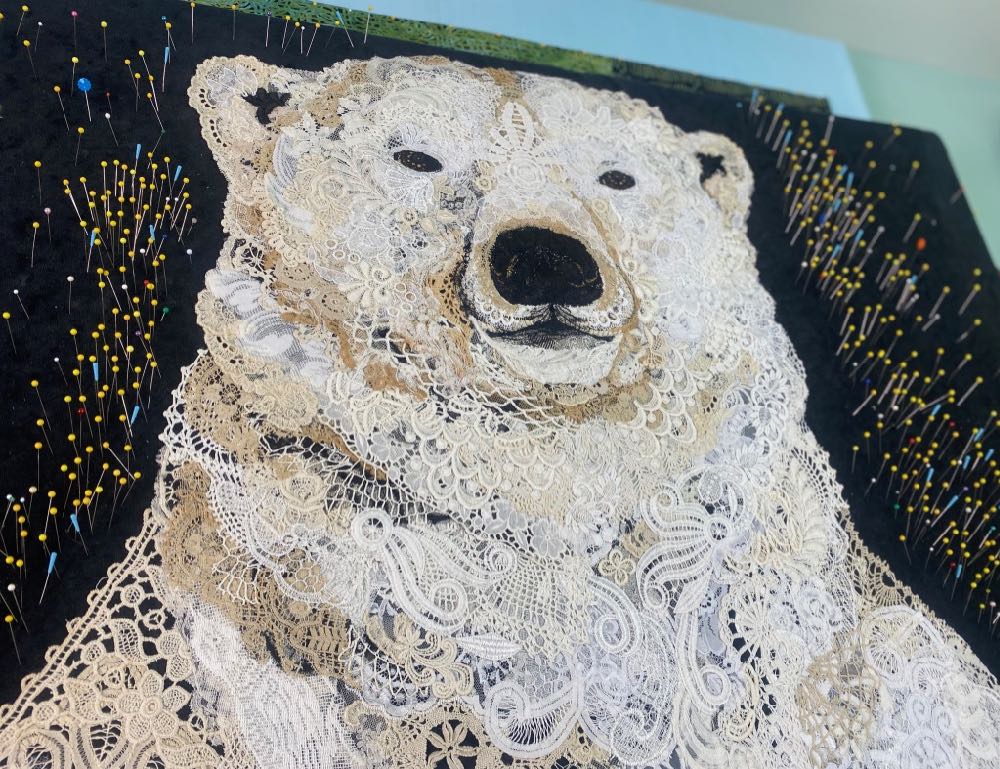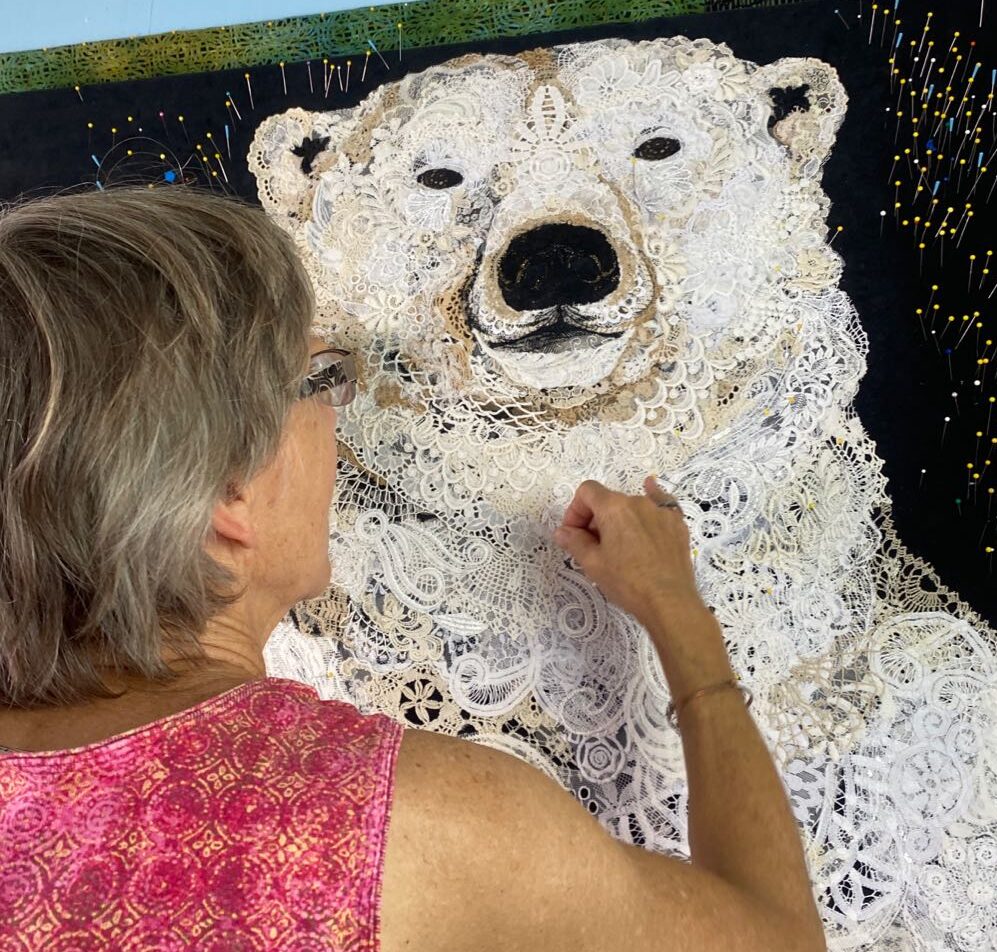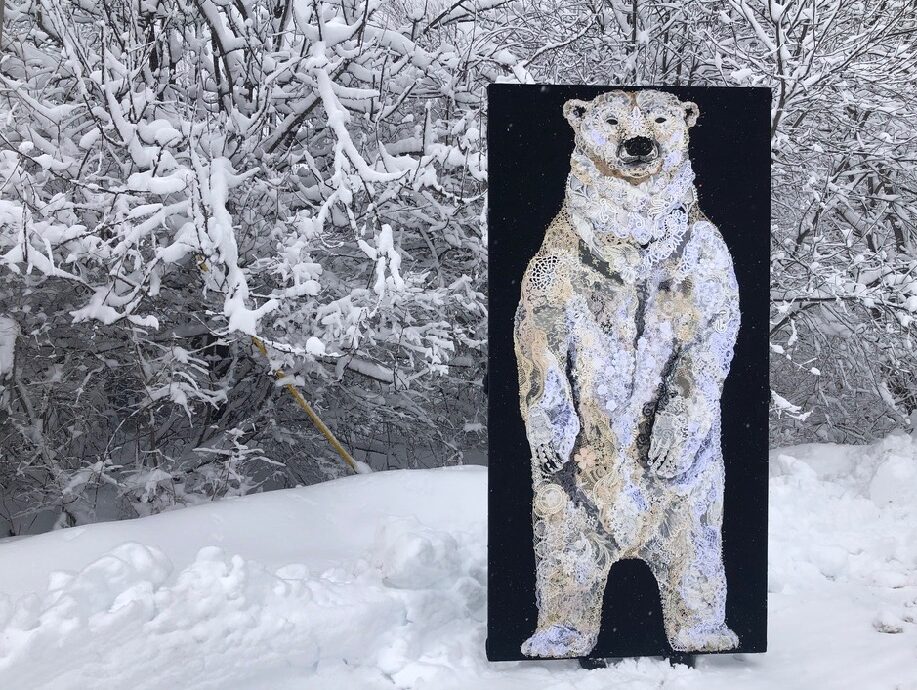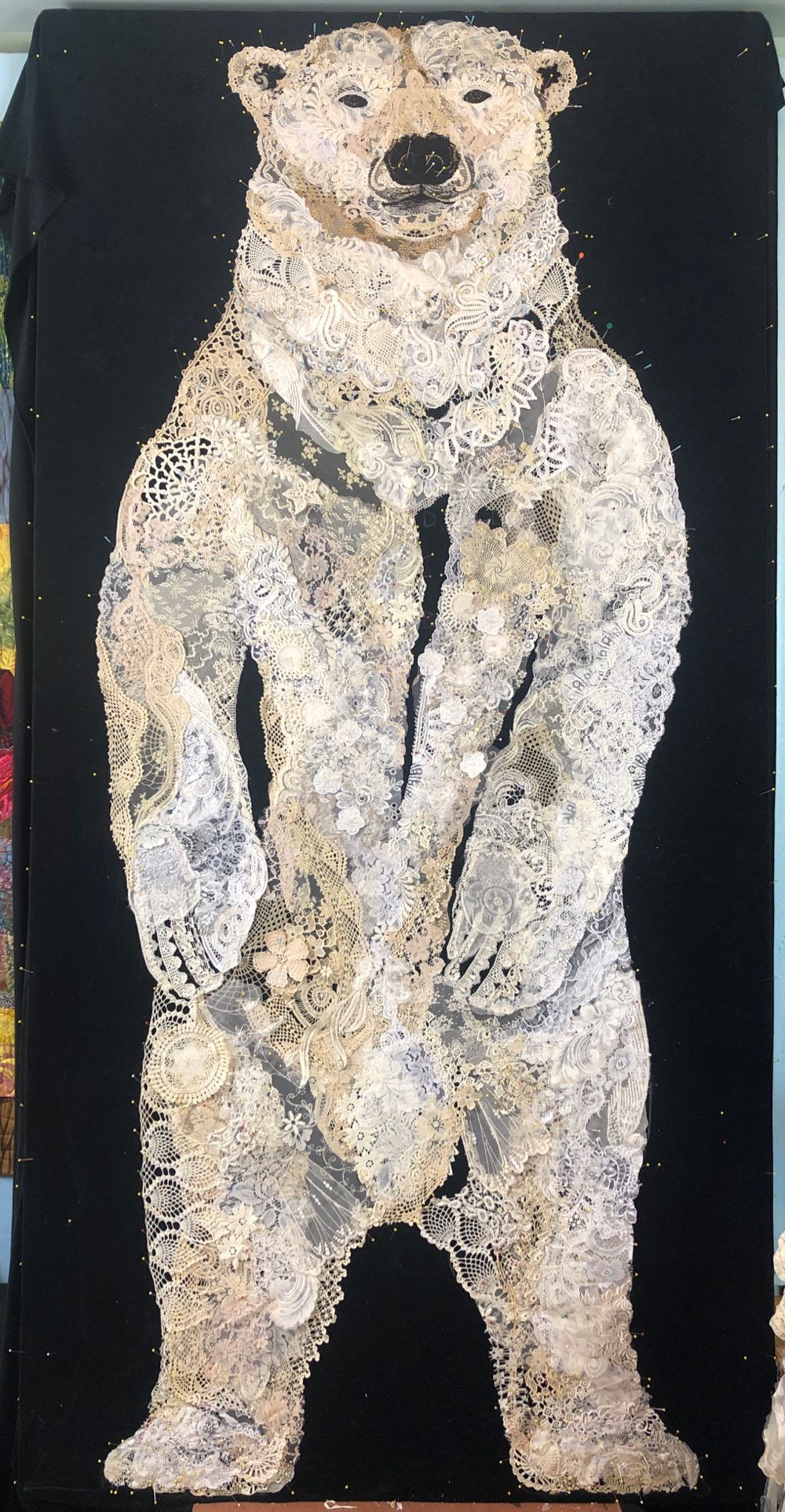Creating art doesn’t happen in a hermetically sealed bubble from which the our day-to-day lives are banished. For those who create art, the events in their lives have a profound impact on their work. At least that’s the way it is for me. I can’t unlink a quilt from my memories or my feelings—nor would I want to. When I look at “Winfrieda” it will, in part, transport me back to a bittersweet era of my life.
The last year or more since I began “Winfrieda”—during most of which I (along with my sister Heidi) have been either caretaking for my parents or mourning their deaths or packing up their home—has been, so far, the most difficult time in my life. It has been a real challenge trying to carve out time to be creative while caring for parents, giving attention to the rest of family members, making sure to still celebrate the special days and times, and oh yeah keep my business going.
If this balancing of many responsibilities sounds familiar to you, that may be because this has been the story of humanity—and especially women—since forever.
Take for example, my Oma Frieda, my mama’s mother, for whom “Winfrieda” is named. That’s her below, holding my uncle Günter. Do you see the expression on her face? It is the face of determination, of one who raised a family of seven children in wartime and postwar Germany. This is the face of one who has seen hardship and has not given up.
That was the expression I wanted to give my polar bear. While “Winfrieda” does not particularly resemble my Oma Frieda (obviously), I think I captured the expression. Of that I feel a satisfying level of achievement. Winfrieda is a matriarch, as is my Oma Frieda, they have the mama-bear spirit—they’re doing their best and going without, in order to ensure their children survive.
But they are also facing us and staring us down—confronting us as if to say, they did their part, the rest is up to us. Human and animal species are so intricately woven together—like lace. I listened to audio books about the Arctic as I worked on this collage quilt, and the interaction between us and the polar ice and animals is not very uplifting. We may be exhausted by the message of how our treatment of the planet is pushing so many species to the edge of extinction and beyond, but I hope we find an answer to at least mitigate the damage we have done and learn to better live with our many co-inhabitants of the planet.
As I try to figure out my own thoughts on this pressing subject, I will return you to the third and final installment of the making of Winfrieda, my lace polar bear.
In Progress: Winfrieda the Lace Polar Bear—Third Draft and Finished!
Drafts are great. Working in drafts is working in stages, knowing that there are edits to come, and it’s expected that you’ll be making adjustments before the end. It takes some of the pressure off of thinking that a project needs to be “perfect” from the beginning. But the third draft is more or less the final draft—so a bit of the pressure is back on—especially when there’s a deadline. And for me, I had a deadline to deliver Winfrieda to the New England Quilt Museum at the end of August. Easy-peazy—after all, the second draft was almost done when I wrote the previous “Part 2” post in April. The post covering Winfrieda’s First Draft was posted in January.
(A reminder to my readers that you can view photos larger by double clicking on them.)
“Almost done with the second draft” referred to one of Winfrieda’s front paws. The photo above left, has an edited paw on the left, and the paw to the right is still in first draft status.
If you compare the photos above, with the one below, you can see the second draft adjustments I made, basically applying the things I liked with the left paw to the one on the right—such as a heavier beige lace on the top of the paw, “fingers” that curve inward (instead of extended), and well defined claws. Now, time to move on to the third draft.
I sat down with my guys, Tom and our son Sam, and we critiqued Winfrieda’s progress—my third draft list. Both Tom and Sam have good observation skills and they understand where I’m going—and if not, they ask questions to clarify if I’m on course or not. Or they just point out what they don’t like or understand, usually tempered with what they do like.
In this critique round, Tom admitted he never really liked the positioning and proportion of the arm and hand on our right (the one I had recently redone). I didn’t really want to hear that, but when I stepped back and looked objectively at what he was pointing out, I could see what he was saying, as well as most of the other things the guys brought up. So one-by-one, I reviewed my notes, looking closely at each point and making edits on Winfrieda, or not. Sometimes, one has to take artistic license and go with something, “just because you like it.” Not everything has to make sense—a little magical realism is good—especially for my Winfrieda.
When I thought about Tom’s suggestion to “mirror” the arms and hands (we had all agreed that the arm and hand on the left worked well), I figured out how to test the idea first. I taped together a few pages of tracing paper and pinned them on top of the arm and hand on our left, and traced the outline. Then I flipped the drawing and placed it in position on the right (photos below).
Since it was quite distracting to see how a repositioned arm would look with the original version showing up from under it, I took a piece of white lace and covered up that part of the collage.(photo below right). And I had to agree with Tom, I liked it better. So I took a deep breath and began removing lace that had already been glued in place, of course.
The photos above left, show the messy scary process of deconstruction and reconstruction—spritzing a little water onto the lace will begin to dissolve the water-soluble glue and it pulled off fairly easily. The resulting hole then needed to be filled in with more beautiful lace, for her belly, below.
After that third draft revision of the arm and hand, I was ready for a change of view, so back up on the scaffolding it was to work on Winfrieda’s face, again. My cat Djinni, likes to join me there, giving me help and encouragement and a heightened sense of awareness to check where she is before I move my feet.
In comparing these photos above and below, you can see the progress from beginning to end of the third draft of Winfrieda’s face. Shadows came and went, a favorite crochet medallion moved from bridge of nose to forehead. Her nose itself got smaller, and her muzzle thinned out, among other edits.
I found a place to use the half of a coffee-dyed doily discovered in my mom’s stash—something I really wanted to use somewhere. When I first placed it in the shadowed side of Winfrieda’s face (above right), it was too heavy and obvious. But a few snips here and layers of lighter lace there, and it eventually got incorporated (lower left). The lighter weight lace that worked very nicely to blend in the doily, was from my mom’s wedding dress fabric—you can see a larger piece of it hanging in the center of photo, below right. (Remember, you can click on photos to view them larger.)
I put off working on polar bear feet for as long as possible—I hadn’t touched them since the first draft was completed. In the photographs I was working with, the feet were either buried in snow or were turned the wrong way or were too far away to see well enough, so I avoided them for awhile. Other photos weren’t really helpful, since when a polar bear is facing you, the feet are foreshortened and look very “stumpy.” My Winfrieda was not going to have stumpy feet. She needed feet of substance to stand up on. After about three tries, I got to what you see below, and I was satisfied.
For a little fun, I added some whisps of fur to her inner legs. I had heard in one of the polar bear books that the hair on their back legs is quite long, so I gave it a try.
In the process of learning about and observing the foot structure of a polar bear, I realized that my understanding of the front paws was all wrong. Where I had created claws was actually the shadowed space between the claws. In the photos below, I’ve made the (fourth draft) corrections to both front paws and I’m finally satisfied with them.
At this point, Winfrieda is quite close to being done. Any corrections made are going to be minor and subtle to see, but can still make a bit of a difference in the overall effect. When asked how I know if a collage is finished, I may joke that it’s when I hit the deadline. You may chuckle, or nod your head in agreement, but it’s true. Not the best of traits, I don’t necessarily recommend it. I wonder though, when and if I ever find myself finishing a quilt early, if I keep finding more to add anyway.
I included the photo below right, as a mood shot of my studio with morning sunshine and Djinni cat waiting for me. I noticed that in the dim light of closing up the studio at night, or around dawn, it was a good time to sit back and study this piece. Things that I hadn’t noticed when the studio lights were on, showed up better in less light—value changes mostly. But it was interesting how the little bits of glittered lacy tulle I add for whispy highlights sparkled like ice when I moved around in the darkened room.
Tom seemed to time his visits to the studio for when I was gluing. The pins would come out of the bear as I glued and I would stick them into the background around Winfrieda so they’d be handy when I needed them next. I think Tom found it interesting how so many pins could hide in the lace.
The following photos are a few to end with: layers of lace pinned and ready to glue, images completely glued with pins creating an aura around Winfrieda, closeups of the finished collage, including the “problem paw,” and a outdoor retake of a photo originally shot in a March snowstorm, but this time on a late summer morning.
In photos below: The last step to preparing Winfrieda for her trip to the quilt museum was to unpin her background from the pinning board and to “massage” her with a lint roller, somehow there was a fair amount of cat hair on her. She cleaned up very nicely. The museum is about a three hour drive from my home, so I took the advantage to stop overnight to visit a good friend along the way. Of course Winfrieda had to say hi as well, stretched out on my friend’s carpet.
Arrival and delivery to the New England Quilt Museum in Lowell, Massachusetts. As much as I will miss seeing Winfrieda in my studio, it was lovely to have her make her debut at NEQM and get out in public.
If you missed this past Thursday’s Zoom presentation of the 12th and final installment of Winfrieda’s Fly on the Wall: Studio Watch, you can view it below, all one hour and thirty-eight minutes! Grab a cuppa or two, and enjoy.
As you can see in the photos below, Djinni is quite excited about our new pair of
Fly on the Wall: Studio Watch Series—all on Thursdays at 7:00 p.m. Eastern Time
African Fabric Leopard—November 16 & 30, December 7 & 14, 2023
(skipping over Thanksgiving Day)
Quilter’s Trophy Fish—February 1, 8, 15, and 22, 2024.
We hope you’ll join us. More information below at end of post.
In Progress: Winfrieda the Lace Polar Bear—Part 2
I’m now backtracking to the previous second and first draft posts to give you the full collection of Quilt Story posts of Winfrieda. Each will have a short overview of what is covered and a link to the full post.
As I already said, the second draft is about touching up what I already laid down. I spent a lot of time on Winfrieda’s face, since it was critical to get her expression exactly right. You can see the stages I went through in the photos below. Many times a change may be almost too subtle to notice, but it is important to put time into the features.
The paws were another challenging spot. While not as critical as the face, the paws needed to feel right or else she just wouldn’t be believable. When we view a piece of art, we may notice that something is somehow “off” (in our opinion). We might not know exactly what is bothering us, but it’s enough to take us out of the state of appreciation for the piece.
And of course as you can see in the picture above, I dealt with those open shadows from the first draft. Here might be a good time to mention that different parts of the quilt progressed at different speeds. For me, it’s usually the face that gets the most attention, so even though I say it’s the second draft, the face might delve into the third or even a fourth draft, with even more adjustments to come. It can definitely be a part of the process.
For the in-depth story of the creation of Winfrieda’s second draft, visit this link.
Susan Carlson Fabric Collage: “Winfrieda” the Lace Polar Bear—First Draft
You may be familiar with how I speak of working in drafts. (If not here’s a post on the topic.) The quick-and-easy, down-and-dirty form of the idea I use in class is: “You gotta get something down before you can fix it up.” In other words, don’t expect your fabric collage to be finished in one pass. Most often my quilts go through three (or more) drafts: one to get something down, another to fix up what I’ve put down, and a third to fix all those last niggling details. Winfrieda was no exception to this.
There’s no hard line that determines when the first draft is finished, but typically I say the first draft is done when your foundation fabric is covered. Even though I left a few “holes” in Winfrieda’s shadowed areas, they were negligible enough to ignore until I revisited them in the second draft.
Despite her size—life-size for a female polar bear—she started just like any other of my quilts. Find a photo (or several photos) that I like, create a sketch or tracing, transfer the tracing to my foundation fabric. Typically I will have a drawing enlarged at a copy store to the finished size of the quilt, but in this case that wasn’t going to work. I generally trace the paper pattern through my foundation fabric, and the shear scale would have made it unfeasible. In Winfrieda’s case my background was a piece of black velvet. So I had to revert to an old-fashioned method of scaling up using a grid. Each square inch of my drawing equaled one square foot of my quilt. Using a piece of soap and a dress-makers chalk I sketched the drawing onto the background.
For an in-depth story of the creation of Winfrieda’s first draft, visit this link.
This video introduces the Fly on the Wall: Susan Carlson Studio Watch Series.
Registration is open for my new 2023 and 2024 Fly on the Wall:Studio Watch series:
If you enjoyed this journey with Winfrieda, you may be interested in two more webinars I have scheduled. In these four-week series you will follow along as I work on two fabric collage quilts. Learn my thought process, my approach for choosing fabrics, and other insights. For more information about these upcoming fabric collage learning opportunities, visit this link.
African Fabric Leopard
November 16 & 30, December 7 & 14, 2023—7:00 p.m. Eastern Time
Each session will last roughly 1-1/2 hours.
Price: $78
USE THIS LINK TO REGISTER
Quilter’s Trophy Fish
February 1, 8, 15, and 22, 2024—7:00 p.m. Eastern Time
Each session will last roughly 1-1/2 hours.
Price: $78
USE THIS LINK TO REGISTER
















































































Absolutely stunning. This post was so enjoyable … it made me feel like you took us on this journey. Winfrieda is inspiring!!!
I have followed the progress on Winfrieda with absolute amazement. Each post made her look more convincing until finally, she just comes to life. Your work can’t be expressed in words but in open-mouthed awe. Question…is she quilted or is that just a flimsy? How do you intend to finish her?
Susan your polar bear is BEAUTIFUL. What a gifted artist you are!
Dear Susan and Tom
I attended your Zoom on the 10th (here in Denmark it was one o’clock in the night) and I want to thank you so, so much for this mindblowing experience! I was totally lost in time and place for the entire time and I loved every second of it.
Thank you for sharing your fantastic talent, Susan. You really are exceptionally skilled. And thank you for sharing your “problems” and hurdles so openly. It gives me the courage to start a new project (hopefully) soon!
Love
Heidi
Bravo on this marvellous achievement!
Your honesty in describing the ups and downs of creating such a piece has been inspiringly supportive. I am so lucky to have such a generous spirit as yourself in my life to follow. ❤️
Congratulations!!! Winfrieda is gorgeous ❤️
An amazing and beautiful work of art!
Absolutely incredible! Thanks for sharing your process as you completed this masterpiece. Did you quilt her?